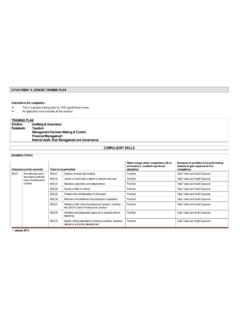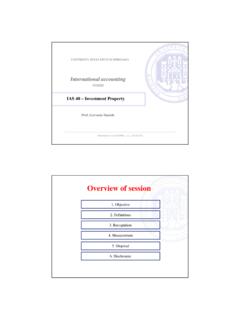Transcription of Investment Property - Calculus
1 IASB documents published to accompanyInternational accounting Standard 40 Investment PropertyThe text of the unaccompanied ias 40 is contained in Part A of this edition. Its effectivedate when issued was 1 January 2005. The effective date of the most recent amendments is1 January 2013. This part presents the following accompanying documents:APPROVAL BY THE BOARD OF ias 40 ISSUED IN DECEMBER 2003 IASB BASIS FOR CONCLUSIONS ON ias 40 (AS REVISED IN 2003)IASC BASIS FOR CONCLUSIONS ON ias 40 (2000) ias 40 IFRS FoundationB1793 Approval by theBoard of ias 40 issued in December 2003 international accounting Standard 40 investment property (as revised in 2003) was approvedfor issue by the fourteen members of the international accounting standards David TweedieChairmanThomas E JonesVice-ChairmanMary E BarthHans-Georg BrunsAnthony T CopeRobert P GarnettGilbert G lardJames J LeisenringWarren J McGregorPatricia L O MalleyHarry K SchmidJohn T SmithGeoffrey WhittingtonTatsumi YamadaIAS 40 IFRS FoundationB1794 Basis for Conclusions onIAS 40 Investment PropertyThis Basis for Conclusions accompanies, but is not part of, IAS Basis for Conclusions summarises the international accounting StandardsBoard s considerations in reaching its conclusions on revising ias 40 InvestmentPropertyin 2003.
2 Individual Board members gave greater weight to some factorsthan to July 2001 the Board announced that, as part of its initial agenda of technicalprojects, it would undertake a project to improve a number of standards ,including ias 40 . The project was undertaken in the light of queries andcriticisms raised in relation to the standards by securities regulators,professional accountants and other interested parties. The objectives of theImprovements project were to reduce or eliminate alternatives, redundanciesand conflicts within standards , to deal with some convergence issues and tomake other improvements. In May 2002 the Board published its proposals in anExposure Draft ofImprovements to international accounting standards , with acomment deadline of 16 September 2002.
3 The Board received over 160 commentletters on the Exposure the Board s intention was not to reconsider the fundamental approachto the accounting for Investment Property established by ias 40 , this Basis forConclusions does not discuss requirements in ias 40 that the Board has notreconsidered. The IASC Basis for Conclusions on ias 40 (2000) follows this interests held under an operating leaseBC4 Paragraph 14 of IAS 17 Leasesrequires a lease of land with an indefiniteeconomic life to be classified as an operating lease, unless title is expected topass to the lessee by the end of the lease term. Without the provisions of IAS 40as amended, this operating lease classification would prevent a lessee fromclassifying its interest in the leased asset as an Investment Property inaccordance with ias 40 .
4 As a result, the lessee could not remeasure its interestin the leased asset to fair value and recognise any change in fair value in profitor loss. However, in some countries, interests in Property (including land) arecommonly or exclusively held under long-term operating leases. The effect ofsome of these leases differs little from buying a Property outright. As a result,some contended that such leases should be accounted for as finance leases orinvestment Property , or as Board discussed possible solutions to this issue. In particular, it considereddeleting paragraph 14 of IAS 17, so that a long-term lease of land would beclassified as a finance lease (and hence could qualify as an Investment Property )when the conditions for finance lease classification in paragraphs 4 13 of IAS 17are met.
5 However, the Board noted that this would not resolve all casesIAS 40 BC IFRS FoundationB1795encountered in practice. Some leasehold interests held for Investment wouldremain classified as operating leases (eg leases with significant contingent rents),and hence could not be Investment Property in accordance with IAS the light of this, the Board decided to state separately in paragraph 6 (ratherthan amend ias 40 s definition of Investment Property ) that a lessee s interest inproperty that arises under an operating lease could qualify as investmentproperty. The Board decided to limit this amendment to entities that use thefair value model in ias 40 , because the objective of the amendment is to permituse of the fair value model for similar Property interests held under finance andoperating leases.
6 Put another way, a lessee that uses the cost model for aproperty would not be permitted to recognise operating leases as assets. TheBoard also decided to make the change optional, ie a lessee that has an interestin Property under an operating lease is allowed, but not required, to classify thatproperty interest as Investment Property (provided the rest of the definition ofinvestment Property is met). The Board confirmed that this classificationalternative is available on a Property -by- Property a lessee s interest in Property held under an operating lease is accountedfor as an Investment Property , the Board decided that the initial carryingamounts of that interest and the related liability are to be accounted for as if thelease were a finance lease.
7 This decision places such leases in the same positionas Investment properties held under finance leases in accordance with theprevious version of IAS doing so, the Board acknowledged that this results in different measurementbases for the lease asset and the lease liability. This is also true for ownedinvestment properties and debt that finances them. However, in accordancewith IAS 39 Financial Instruments: Recognition and Measurement,1as revised in 2003,an entity can elect to measure such debt at fair value, but lease liabilities cannotbe remeasured in accordance with IAS Board considered changing the scope of IAS 39, but concluded that thiswould lead to a fundamental review of lease accounting , especially in relation tocontingent rentals.
8 The Board decided that this was beyond the limitedrevisions to ias 40 to facilitate application of the fair value model to someoperating leases classified as Investment properties. The Board did, however,indicate that it wished to revisit this issue in a later project on lease Board also noted that this was the view of the Board of the former IASC asexpressed in its Basis for Conclusions, in paragraphs B25 and , the Board noted that the methodology described in paragraphs 40 and50(d) of ias 40 , whereby a fair valuation of the Property that takes all leaseobligations into account is adjusted by adding back any liability that is1 In November 2009 and October 2010 the Board amended some of the requirements of IAS 39 andrelocated them to IFRS 9 Financial Instruments.
9 IFRS 9 applies to all items within the scope of IAS BC8 refers to matters relevant when ias 40 was issued2 These paragraphs in the IASC Basis are no longer relevant and have been 40 BC IFRS FoundationB1796recognised for these obligations, would, in practice, enable entities to ensurethat net assets in respect of the leased interest are not affected by the use ofdifferent measurement choice between the cost model and the fair value modelBC11 The Board also discussed whether to remove the choice in ias 40 of accountingfor Investment Property using a fair value model or a cost Board noted that IASC had included a choice for two main reasons. The firstwas to give preparers and users time to gain experience with using a fair valuemodel.
10 The second was to allow time for countries with less-developed propertymarkets and valuation professions to mature. The Board decided that more timeis needed for these events to take place ( ias 40 became mandatory only forperiods beginning on or after 1 January 2001). The Board also noted thatrequiring the fair value model would not converge with the treatment requiredby most of its liaison standard-setters. For these reasons, the Board decided notto eliminate the choice as part of the Improvements project, but rather to keepthe matter under review with a view to reconsidering the option to use the costmodel at a later Board did not reconsider ias 40 in relation to the accounting by definition of Investment Property requires that such a Property is held bythe owner or a lessee under a finance lease.











